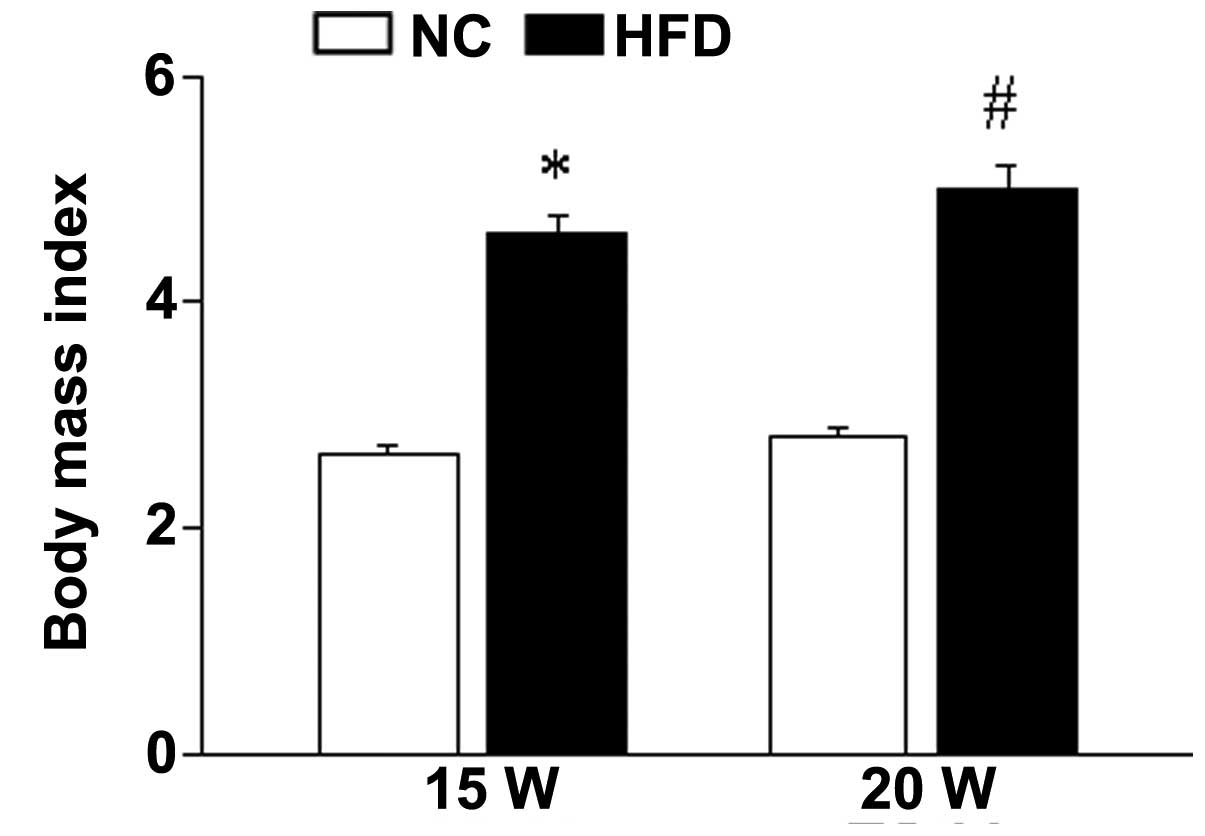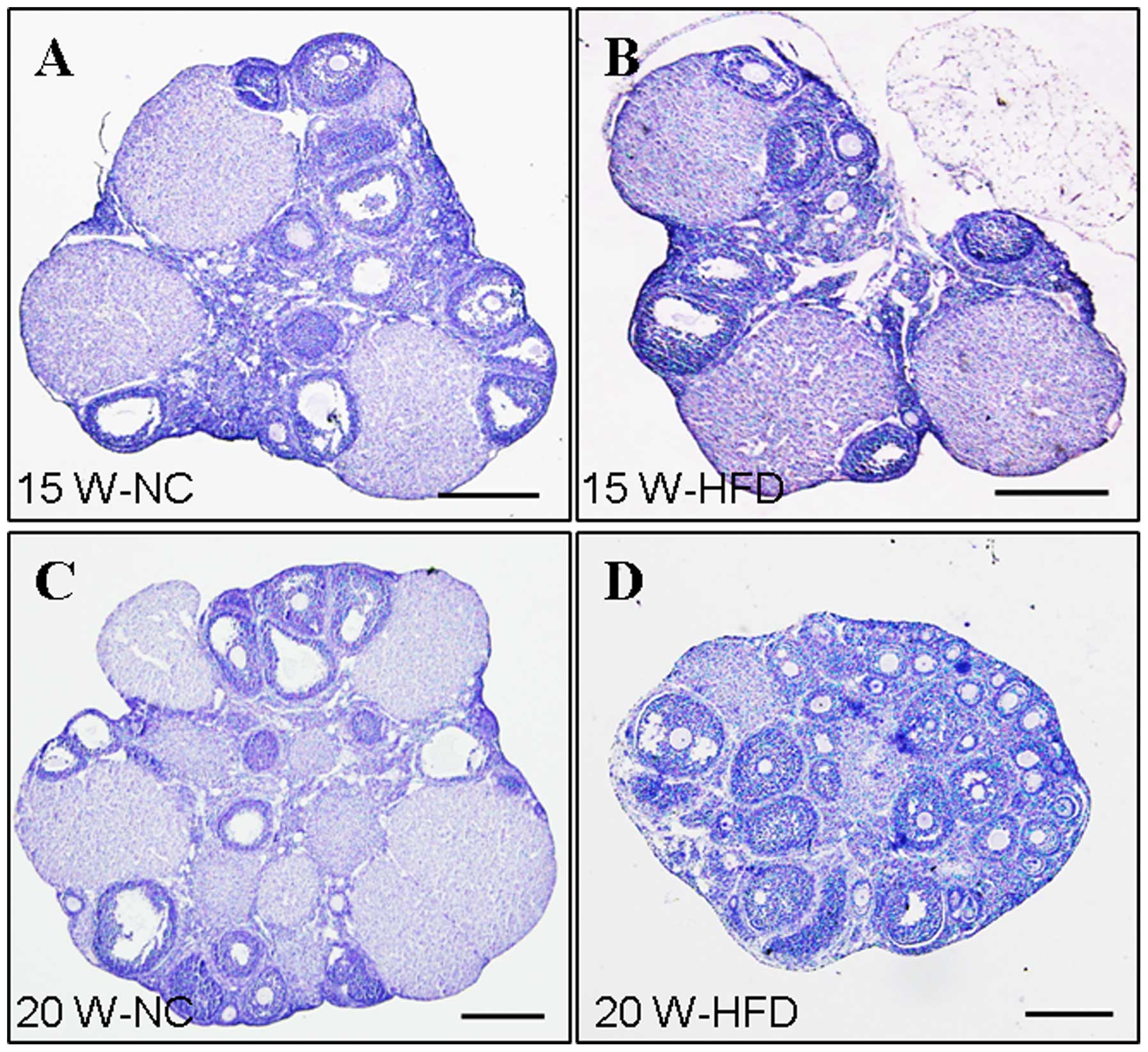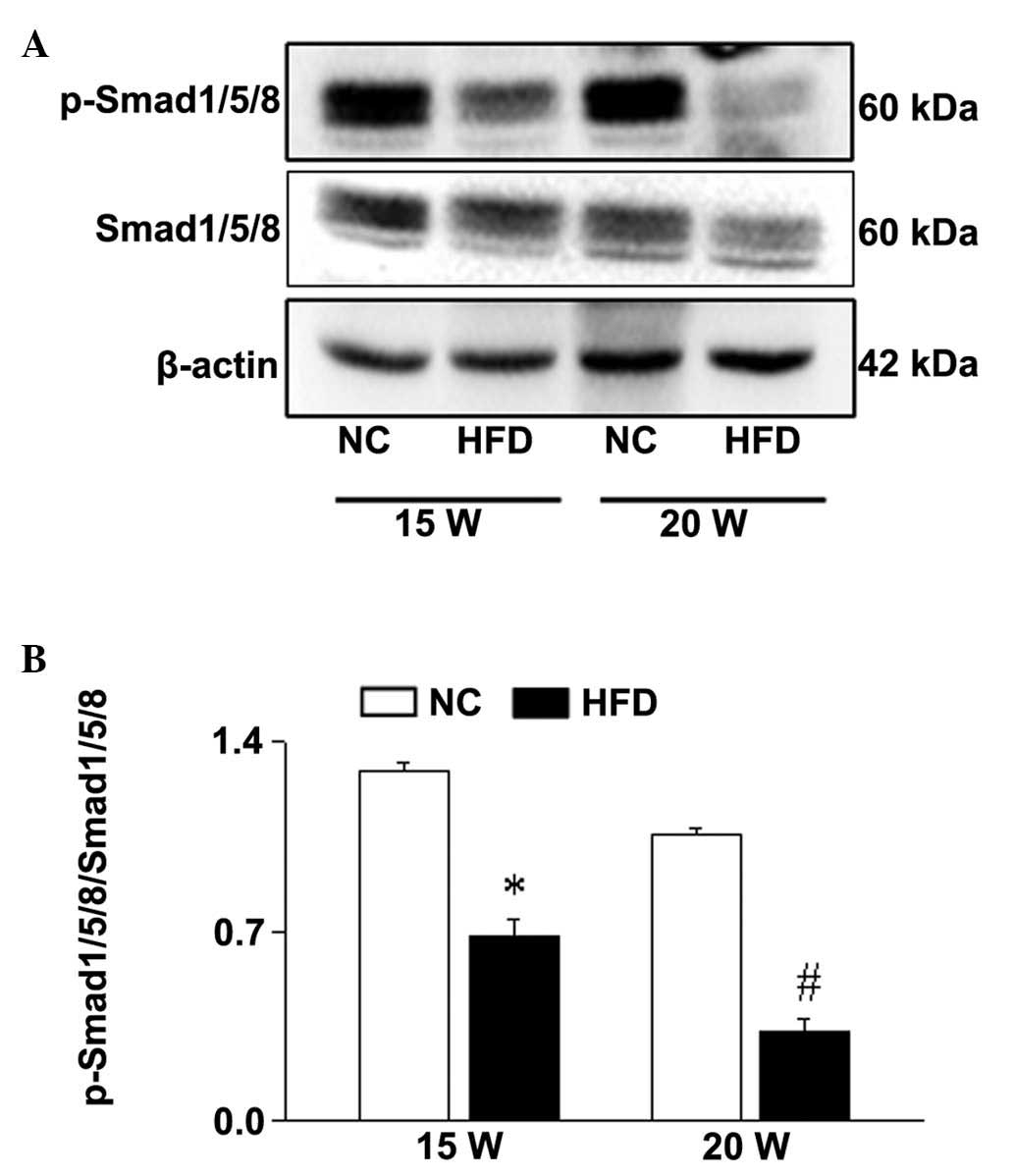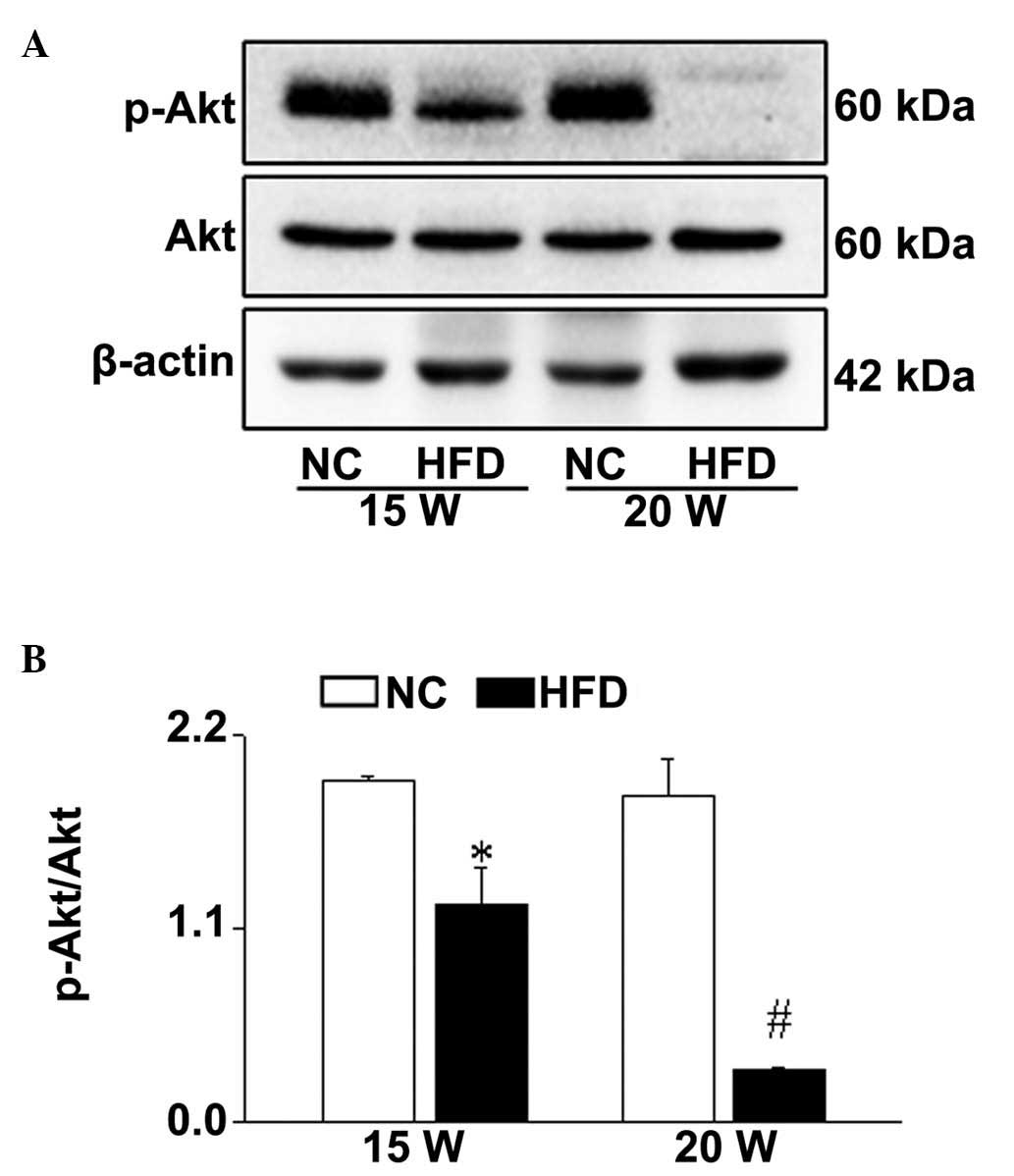|
1
|
Akamine EH, Marçal AC, Camporez JP,
Hoshida MS, Caperuto LC, Bevilacqua E and Carvalho CR: Obesity
induced by high-fat diet promotes insulin resistance in the ovary.
J Endocrinol. 206:65–74. 2010. View Article : Google Scholar : PubMed/NCBI
|
|
2
|
Wu Y, Wang F, Fu M, Wang C, Quon MJ and
Yang P: Cellular stress, excessive apoptosis and the effect of
metformin in a mouse model of type 2 diabetic embryopathy.
Diabetes. 64:2526–2536. 2015. View Article : Google Scholar : PubMed/NCBI
|
|
3
|
Wamae CN: Advances in the diagnosis of
human lymphatic filariases: A review. East Afr Med J. 71:171–182.
1994.PubMed/NCBI
|
|
4
|
Metwally M, Li TC and Ledger WL: The
impact of obesity on female reproductive function. Obes Rev.
8:515–523. 2007. View Article : Google Scholar : PubMed/NCBI
|
|
5
|
Legro RS: Evaluation and Treatment of
Polycystic Ovary Syndrome. Practice. 17:82–85. 2000.
|
|
6
|
Pasquali R and Casimirri F: The impact of
obesity on hyperandrogenism and polycystic ovary syndrome in
premenopausal women. Clin Endocrinol (Oxf). 39:1–16. 1993.
View Article : Google Scholar
|
|
7
|
Richards JS and Pangas SA: The ovary:
Basic biology and clinical implications. Journal Clin Invest.
120:963–972. 2010. View
Article : Google Scholar
|
|
8
|
Castrillon DH, Miao L, Kollipara R, Horner
JW and DePinho RA: Suppression of ovarian follicle activation in
mice by the transcription factor Foxo3a. Science. 301:215–218.
2003. View Article : Google Scholar : PubMed/NCBI
|
|
9
|
Nteeba J, Ross JW, Perfield JW II and
Keating AF: High fat diet induced obesity alters ovarian
phosphatidylinositol-3 kinase signaling gene expression. Reprod
Toxicol. 42:68–77. 2013. View Article : Google Scholar : PubMed/NCBI
|
|
10
|
Uhlenhaut NH and Treier M: Forkhead
transcription factors in ovarian function. Reproduction.
142:489–495. 2011. View Article : Google Scholar : PubMed/NCBI
|
|
11
|
Liu L, Rajareddy S, Reddy P, Du C,
Jagarlamudi K, Shen Y, Gunnarsson D, Selstam G, Boman K and Liu K:
Infertility caused by retardation of follicular development in mice
with oocyte-specific expression of Foxo3a. Development.
134:199–209. 2007. View Article : Google Scholar
|
|
12
|
John GB, Shirley LJ, Gallardo TD and
Castrillon DH: Specificity of the requirement for Foxo3 in
primordial follicle activation. Reproduction. 133:855–863. 2007.
View Article : Google Scholar : PubMed/NCBI
|
|
13
|
Dong J, Albertini DF, Nishimori K, Kumar
TR, Lu N and Matzuk MM: Growth differentiation factor-9 is required
during early ovarian folliculogenesis. Nature. 383:531–535. 1996.
View Article : Google Scholar : PubMed/NCBI
|
|
14
|
Elvin JA, Clark AT, Wang P, Wolfman NM and
Matzuk MM: Paracrine actions of growth differentiation factor-9 in
the mammalian ovary. Mol Endocrinol. 13:1035–1048. 1999. View Article : Google Scholar : PubMed/NCBI
|
|
15
|
Elvin JA, Yan C, Wang P, Nishimori K and
Matzuk MM: Molecular characterization of the follicle defects in
the growth differentiation factor 9-deficient ovary. Mol
Endocrinol. 13:1018–1034. 1999. View Article : Google Scholar : PubMed/NCBI
|
|
16
|
Vitt UA, McGee EA, Hayashi M and Hsueh AJ:
In vivo treatment with GDF-9 stimulates primordial and primary
follicle progression and theca cell marker CYP17 in ovaries of
immature rats. Endocrinology. 141:3814–3820. 2000.PubMed/NCBI
|
|
17
|
Vitt UA, Hayashi M, Klein C and Hsueh AJ:
Growth differentiation factor-9 stimulates proliferation but
suppresses the follicle-stimulating hormone-induced differentiation
of cultured granulosa cells from small antral and preovulatory rat
follicles. Biol Reprod. 62:370–377. 2000. View Article : Google Scholar : PubMed/NCBI
|
|
18
|
Sánchez F and Smitz J: Molecular control
of oogenesis. Biochim Biophys Acta. 1822:1896–1912. 2012.
View Article : Google Scholar : PubMed/NCBI
|
|
19
|
Paulini F and Melo EO: The role of
oocyte-secreted factors GDF9 and BMP15 in follicular development
and oogenesis. Reprod Domest Anim. 46:354–361. 2011. View Article : Google Scholar : PubMed/NCBI
|
|
20
|
Gilchrist RB, Lane M and Thompson JG:
Oocyte-secreted factors: Regulators of cumulus cell function and
oocyte quality. Hum Reprod Update. 14:159–177. 2008. View Article : Google Scholar : PubMed/NCBI
|
|
21
|
McCulley DJ, Kang JO, Martin JF and Black
BL: BMP4 is required in the anterior heart field and its
derivatives for endocardial cushion remodeling, outflow tract
septation, and semilunar valve development. Dev Dyn. 237:3200–3209.
2008. View Article : Google Scholar : PubMed/NCBI
|
|
22
|
Su YQ, Sugiura K, Wigglesworth K, O'Brien
MJ, Affourtit JP, Pangas SA, Matzuk MM and Eppig JJ: Oocyte
regulation of metabolic cooperativity between mouse cumulus cells
and oocytes: BMP15 and GDF9 control cholesterol biosynthesis in
cumulus cells. Development. 135:111–121. 2008. View Article : Google Scholar
|
|
23
|
Sugiura K, Su YQ, Diaz FJ, Pangas SA,
Sharma S, Wigglesworth K, O'Brien MJ, Matzuk MM, Shimasaki S and
Eppig JJ: Oocyte-derived BMP15 and FGFs cooperate to promote
glycolysis in cumulus cells. Development. 134:2593–2603. 2007.
View Article : Google Scholar : PubMed/NCBI
|
|
24
|
Wu YQ, Chen LY, Zhang ZH and Wang ZC:
Effects of phosphatidylinositol-3 kinase/protein kinase b/bone
morphogenetic protein-15 pathway on the follicular development in
the mammalian ovary. Zhongguo Yi Xue Ke Xue Yuan Xue Bao.
35:224–228. 2013.In Chinese. PubMed/NCBI
|
|
25
|
Liu H, Luo LL, Qian YS, Fu YC, Sui XX,
Geng YJ, Huang DN, Gao ST and Zhang RL: FOXO3a is involved in the
apoptosis of naked oocytes and oocytes of primordial follicles from
neonatal rat ovaries. Biochem Biophys Res Commun. 381:722–727.
2009. View Article : Google Scholar : PubMed/NCBI
|
|
26
|
Zheng W, Nagaraju G, Liu Z and Liu K:
Functional roles of the phosphatidylinositol 3-kinases (PI3Ks)
signaling in the mammalian ovary. Mol Cell Endocrinol. 356:24–30.
2012. View Article : Google Scholar
|
|
27
|
Adhikari D and Liu K: Molecular mechanisms
underlying the activation of mammalian primordial follicles. Endocr
Rev. 30:438–464. 2009. View Article : Google Scholar : PubMed/NCBI
|
|
28
|
Reddy KK, Lefkove B, Chen LB, Govindarajan
B, Carracedo A, Velasco G, Carrillo CO, Bhandarkar SS, Owens MJ,
Mechta-Grigoriou F and Arbiser JL: The antidepressant sertraline
downregulates Akt and has activity against melanoma cells. Cell
Melanoma Res. 21:451–456. 2008. View Article : Google Scholar
|
|
29
|
Yang P, Li X, Xu C, Eckert RL, Reece EA,
Zielke HR and Wang F: Maternal hyperglycemia activates an
ASK1-FoxO3a-caspase 8 pathway that leads to embryonic neural tube
defects. Sci Signal. 6:ra742013. View Article : Google Scholar : PubMed/NCBI
|
|
30
|
Wu Y, Wang F, Reece EA and Yang P:
Curcumin ameliorates high glucose-induced neural tube defects by
suppressing cellular stress and apoptosis. AM J Obstet Gynecol.
212(802): e801–e808. 2015. View Article : Google Scholar
|
|
31
|
Li X, Xu M, Pitzer AL, Xia M, Boini KM, Li
PL and Zhang Y: Control of autophagy maturation by acid
sphingomyelinase in mouse coronary arterial smooth muscle cells:
Protective role in atherosclerosis. J Mol Med Berl. 92:473–485.
2014. View Article : Google Scholar : PubMed/NCBI
|
|
32
|
Wei YM, Li X, Xu M, Abais JM, Chen Y,
Riebling CR, Boini KM, Li PL and Zhang Y: Enhancement of autophagy
by simvastatin through inhibition of Rac1-mTOR signaling pathway in
coronary arterial myocytes. Cell Physiol Biochem. 31:925–937. 2013.
View Article : Google Scholar : PubMed/NCBI
|
|
33
|
Li X, Gulbins E and Zhang Y: Oxidative
stress triggers Ca-dependent lysosome trafficking and activation of
acid sphingomyelinase. Cell Physiol Biochem. 30:815–826. 2012.
View Article : Google Scholar : PubMed/NCBI
|
|
34
|
Zhang Z, Pang X, Tang Z, Yin D and Wang Z:
Overexpression of hypoxia-inducible factor prolyl hydoxylase-2
attenuates hypoxia-induced vascular endothelial growth factor
expression in luteal cells. Mol Med Rep. 12:3809–3814.
2015.PubMed/NCBI
|
|
35
|
McGee EA and Hsueh AJ: Initial and cyclic
recruitment of ovarian follicles. Endocr Rev. 21:200–214.
2000.PubMed/NCBI
|
|
36
|
Hansen KR, Knowlton NS, Thyer AC,
Charleston JS, Soules MR and Klein NA: A new model of reproductive
aging: The decline in ovarian non-growing follicle number from
birth to menopause. Hum Reprod. 23:699–708. 2008. View Article : Google Scholar : PubMed/NCBI
|
|
37
|
Broekmans FJ, Knauff EA, te Velde ER,
Macklon NS and Fauser BC: Female reproductive ageing: Current
knowledge and future trends. Endocrinol Metab. 18:58–65. 2007.
|
|
38
|
Faddy MJ and Gosden RG: A model conforming
the decline in follicle numbers to the age of menopause in women.
Hum Reprod. 11:1484–1486. 1996. View Article : Google Scholar : PubMed/NCBI
|
|
39
|
Tzivion G, Dobson M and Ramakrishnan G:
FoxO transcription factors; Regulation by AKT and 14-3-3 proteins.
Biochim Biophys Acta. 1813:1938–1945. 2011. View Article : Google Scholar : PubMed/NCBI
|
|
40
|
Reddy P, Zheng W and Liu K: Mechanisms
maintaining the dormancy and survival of mammalian primordial
follicles. Endocrinol Metab. 21:96–103. 2010.
|
|
41
|
Reddy P, Liu L, Adhikari D, Jagarlamudi K,
Rajareddy S, Shen Y, Du C, Tang W, Hämäläinen T, Peng SL, et al:
Oocyte-specific deletion of Pten causes premature activation of the
primordial follicle pool. Science. 319:611–613. 2008. View Article : Google Scholar : PubMed/NCBI
|
|
42
|
John GB, Gallardo TD, Shirley LJ and
Castrillon DH: Foxo3 is a PI3K-dependent molecular switch
controlling the initiation of oocyte growth. Dev Biol. 321:197–204.
2008. View Article : Google Scholar : PubMed/NCBI
|
|
43
|
Otsuka F, Yamamoto S, Erickson GF and
Shimasaki S: Bone morphogenetic protein-15 inhibits
follicle-stimulating hormone (FSH) action by suppressing FSH
receptor expression. J Biol Chem. 276:11387–11392. 2001. View Article : Google Scholar : PubMed/NCBI
|
|
44
|
Wymann MP and Pirola L: Structure and
function of phosphoinositide 3-kinases. Biochim Biophys Acta.
1436:127–150. 1998. View Article : Google Scholar : PubMed/NCBI
|
|
45
|
Whitman M, Downes CP, Keeler M, Keller T
and Cantley L: Type I phosphatidylinositol kinase makes a novel
inositol phospholipid, phosphatidylinositol-3-phosphate. Nature.
332:644–646. 1988. View Article : Google Scholar : PubMed/NCBI
|
|
46
|
Burgering BM and Coffer PJ: Protein kinase
B (c-Akt) in phosphatidylinositol-3-OH kinase signal transduction.
Nature. 376:599–602. 1995. View Article : Google Scholar : PubMed/NCBI
|
|
47
|
Franke TF, Kaplan DR, Cantley LC and Toker
A: Direct regulation of the Akt proto-oncogene product by
phosphatidylinositol-3,4-bisphosphate. Science. 275:665–668. 1997.
View Article : Google Scholar : PubMed/NCBI
|
|
48
|
Huang XL, Xu J, Zhang XH, Qiu BY, Peng L,
Zhang M and Gan HT: PI3K/Akt signaling pathway is involved in the
pathogenesis of ulcerative colitis. Inflamm Res. 60:727–734. 2011.
View Article : Google Scholar : PubMed/NCBI
|















